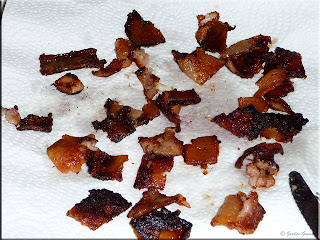I cannot recall a time that pork has been on sale at such low prices. Thanks to all the hype and misinformation over the H1N1 virus we have seen extremely low pork prices. Nice cuts of pork such as the loin, pork shoulder and butt have been going as low as $1 a pound. Recently the savings has expanded to include smoked, cured cuts of pork as well. Smoked Pork Shoulder
Smoked Pork Shoulder
One of the local grocery stores had smoked pork shoulders on for 97¢ per pound. At that price it was well worth picking one up. The total cost for this pork shoulder was $7.79. It was kryovac packaged so could have been frozen for later use. The meat had a mesh holding it together likely for the smoking process. There was a nice piece of skin on the meat. Most recipes with tell you to cross-hatch cut this skin which helps render out the fat but I had other plans for the meat. The skin portion is what I wanted to make a delicious snack called cracklings. I removed that before cooking at 300ºF, skin side up. Part way through the cooking process I glazed the pork shoulder with home canned apple jelly followed by the occasional basting with the glaze until the meat was cooked through. Defatting Pork Skin
Defatting Pork Skin
Leaving the meat without cross-hatching the skin resulted in an extremely moist and tender ham. Prior to serving I gently cut between the meat and fat pulling the skin with the fat in tact away from the meat (1). Laying the knife on its side between the fat and the skin then slowly moving on an angle to separate the two layers is the easiest method to use (2). This removes most of the fat. Holding the knife straight up with blade edge lightly resting on the skin then using a slight scraping motion is the best way to clean any remaining larger pieces of fat (3). It is important to not clean off all of the fat as it is needed to cook the cracklings. Once the skin is defatted I cut it into strips then across to form bite sized pieces (4).
Cracklings are called cracklings for two reasons. First they seriously do jump and crackle while they are cooking. It is imperative that you use a splatter screen to prevent possible burns from the jumping pieces. When the pieces pop, they are quite loud and capable of landing a distance from the pan. Here is a short video I made while cooking the cracklings.
The second reason cracklings are called cracklings is because the crackle when you eat them. The taste and texture is a true delight!
 Pork Cracklings
Pork CracklingsCracklings are cooked until just crispy on medium high heat. It is important to not over cook to the point of burning but not undercook to where the skin is gummy. The end result should be a crunchy texture that softens slightly when chewing yet holds somewhat together almost gum like. I know this is not a really good description of the texture but it's the best I can think of at the moment.
There is not a lot of shrinkage other than losing the fat. I drain the pork cracklings on paper towels to absorb any remaining fat. The pork cracklings are enjoyed as they are without any additional seasonings. They don't look like much but my gosh are they ever delicious!






5 food lovers commented:
OMG... my sainted Grandmother used to make these for the kids as a snack... Have not seen or thought of these for decades... thanks so much for the recipe and the flood of memories
where have i been - i have never seen a screen like that? very useful!
Hi Dave :) You're welcome. Isn't it wonderful that food can trigger such great memories of loved ones?
Hi Chey :) The screen is called a splatter screen. It comes in a variety of sizes. I've noticed the dollar stores are now carrying them. They certainly do come in handy when frying anything that splatters as well as stopping simmering sauces from splattering all over the place.
Hi pandi :) This technique is specific to the pork rind (skin) due to the thickness/texture of the skin and fat backing. Beef and lamb have the skin removed so there is no skin to use but if there were it would be too thin and lacking that fat layer necessary to make the cracklings.
Post a Comment